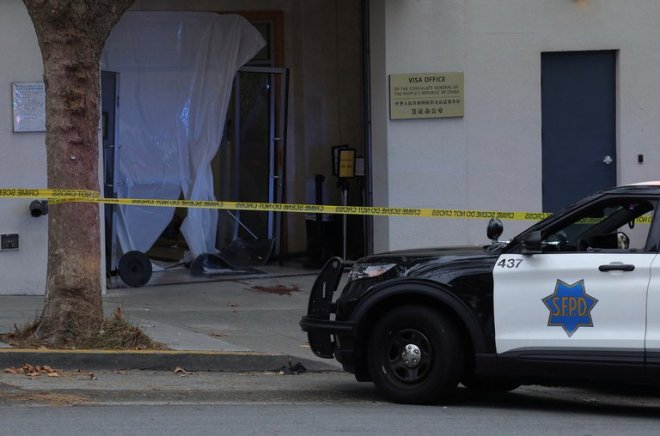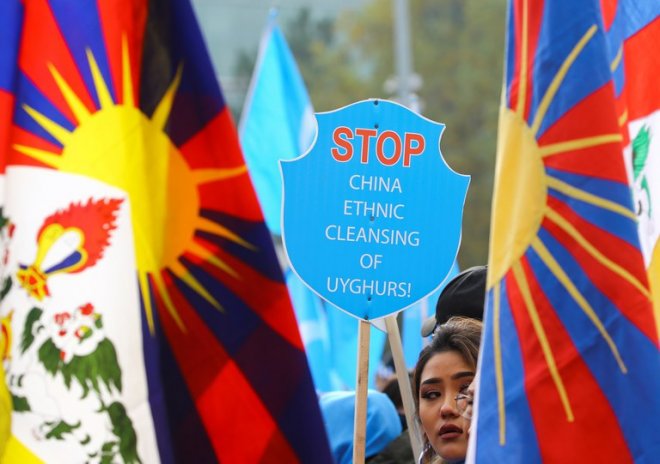Ethnic Karen use innovation to battle wildfire, Thai government regulation
For the past three weeks, Deepunu has slept only a few hours every night.
The 37-year-old charismatic Karen leader has been leading a village youth team to battle wildfires deep in the forest of northern Thailand. The blaze threatens their ethnic village Pa Pae on Doi Chang, a sacred mountain in the Ban Hong district of Lamphun province.
The village of some 70 homes is accessible only by four-wheel drive or motorcycles. Then, it is a few more kilometers of an uphill hike to the wildfire frontline.
“We have been doing 12-hour shifts with six to 12 people,” said Deepunu.
“This year, it has been worse than ever before. It’s drier air, so the fire does not die,” he said. “If we don’t fight, our village will be destroyed.”
![]() Deepunu, a 37-year-old Karen leader from the village of Pa Pae in northern Thailand, has been leading a team to battle wildfires deep in the forest. “If we don’t fight, our village will be destroyed,” he told RFA on April 4, 2023. Credit: Subel Rai Bhandari for RFA
Deepunu, a 37-year-old Karen leader from the village of Pa Pae in northern Thailand, has been leading a team to battle wildfires deep in the forest. “If we don’t fight, our village will be destroyed,” he told RFA on April 4, 2023. Credit: Subel Rai Bhandari for RFA
Ponchai Muehae, 36, who had just returned after a long shift, said the terrain was challenging, and there was no water nearby.
“It is hard work. There is no money, but we do it for the community.”
“We are tired and upset, especially when city people blame us for causing wildfire and pollution. But the team is great, and we raise each other’s spirits,” Ponchai said.
The Karen people, the largest of nine major hill tribes in Thailand, are scattered across the region, including Myanmar and Laos.
“We are forest people,” said Pa Pae’s village elder, Chanchai Gula. “Communities like us live in protected areas. That is why we always have issues with the forest department.”
Karen face a crackdown from authorities, who accuse the community of encroaching on the forest and for burning.
In Thailand, less than a third of the country is forest. The new forest laws were introduced in 2019 to increase it to 40% by 2024.
![]() A villager shows the feed from a mountaintop camera that transmits real-time video, such as the smoke from one of the nearby wildfires, on Doi Chang mountain in northern Thailand, on April 4, 2023. Credit: Subel Rai Bhandari for RFA
A villager shows the feed from a mountaintop camera that transmits real-time video, such as the smoke from one of the nearby wildfires, on Doi Chang mountain in northern Thailand, on April 4, 2023. Credit: Subel Rai Bhandari for RFA
In February 2020, Pa Pae village agreed with the local government to be recognized as “a Special Cultural Area” so they could live and farm traditionally.About 21,000 rai, or 3,360 hectares, of land is now protected under the agreement, the first such deal since the new forest law that allows people to reside or utilize certain forest areas, with conditions, for up to 20 years at a time.
“We are responsible for this land … There is trust in the community now,” Deepunu said.
Innovation to tackle village challenges
Deepunu said he is fighting to bring about change to his village “without changing the village in the process” as they battle government regulation, climate change impacts, and the emigration of youth.
He first saw the smoke in mid-March on his smartphone via one of the two cameras he had installed on a mountaintop to monitor the wildfires. The battery-powered equipment can be controlled remotely since they are attached to wireless sim card routers.
![]() A dozen of 2,000-liter water tanks are kept near an area at risk for fires on Doi Chang mountain, northern Thailand, on April 4, 2023. Credit: Subel Rai Bhandari for RFA
A dozen of 2,000-liter water tanks are kept near an area at risk for fires on Doi Chang mountain, northern Thailand, on April 4, 2023. Credit: Subel Rai Bhandari for RFA
Before, a village survey team had to go to the top of the mountain to check for fires. But now the cameras provide an unobstructed, panoramic live view of the area day and night.
The villagers sometimes use drone cameras to monitor smoke and have installed sensors in different places to measure and record temperature and pollution.
These are some of the innovations in the village to prepare for “changes due to global warming and other issues,” said 58-year-old Chanchai.
“We are facing many challenges. The firebreak line is not working as it did traditionally, so we have to think of new ideas,” he added.
Later this year, the village plans to set up “a water spray system” in the forest, which they can remotely turn on when they know a wildfire is on the way.
“If this idea works, it will be great because other ethnic villages could replicate it,” Deepunu said.
Water is available “at just 60% of previous times,” he added. So, the villagers have stored several 2,000-liter water tanks in risk-prone areas. They have also dug a pond in the middle of the village to hold about 400,000 liters of water.
![]() A Karen villager shows a patch of land in the forest that they farmed in 2022 in Pa Pae, northern Thailand, on April 4, 2023. Credit: Subel Rai Bhandari for RFA
A Karen villager shows a patch of land in the forest that they farmed in 2022 in Pa Pae, northern Thailand, on April 4, 2023. Credit: Subel Rai Bhandari for RFA
The traditional way of farming
Karen communities conduct traditional rotational farming, which requires farmers to burn the area and move their cultivation every year so that the land gets time to regenerate. It has been a sore point with the Thai authorities.
“One family gets a maximum of 5 rai (0.8 hectares) where they grow rice, cassava, and plenty of vegetables. It’s enough,” Jiradet Ngoenkham, a local villager, said.
After cultivation, villagers return to the same area after 7-8 years.
Before and after each harvest, the villagers burn the remains in the farm in a responsible manner, which provides natural nutrients to the soil, said another villager, Kriangkrai Buntha, 37.
“We are cautious. It is never out of control. It has never happened,” he added.
“The rotational cultivation burning is short, fast, and limited, not done all at once. There is not much pollution,” Chi Suwichan Phatthanaphraiwan, a professor of geo-cultural management at Srinakharinwirot University.
However, such slash-and-burn practice has led to public misconceptions about Karen-style farming and air pollution, with the government responding with “zero-burn” policies.
Chatchawan Thongdeelert, a social activist and director of Breath Council, said that approach “blanketly criminalizes the villagers.”
“In the north, we say there are two types of fire: necessary and unnecessary. We will have many unnecessary fires if we do not do necessary ones,” he added.
“We have to be specific about the cause of air pollution. It’s not rotational farming burning, but monoculture agricultural burning, and wildfires.”
Villagers and activists allege things started worsening when industrial-scale farming of maize for animal feed began more than a decade ago, as big companies offered incentives to lure the villagers to switch to the cash crops.
![]() A Catholic priest and Buddhist monks wrap a village tree with an orange robe to protect it from being cut or destroyed in Pa Pae, northern Thailand, on April 4, 2023. Credit: Subel Rai Bhandari for RFA
A Catholic priest and Buddhist monks wrap a village tree with an orange robe to protect it from being cut or destroyed in Pa Pae, northern Thailand, on April 4, 2023. Credit: Subel Rai Bhandari for RFA
Environmentalists blame maize stubble burning as one of the two reasons for the record-breaking air pollution in northern Thailand.
Pa Pae villagers said they had been approached to do contract maize farming but rejected the offer.
“We rejected because it is not according to traditional living,” Deepunu added. “It affects our culture, belief, and relationship with the forest.”
A Catholic priest and Buddhist monks ordain trees
To keep the local government on their side, Pa Pae villagers prepared a mapping survey system, which informs the geo-locations of where the villagers conduct their shifting cultivation each year, as well as important spots, like spiritual and religious sites and cemeteries.
In early April, Pa Pae villagers organized an event to present the data to government officials and other local communities. District and provincial governors and forest department officials attended it.
A Catholic priest and several Buddhist monks wrapped orange clerical robes around trees to protect forests. It was the first time, the villagers said, for the two religious leaders to come together to show common struggle against environmental degradation.
“Karen are accused of destroying the forest, of burning, but they are not doing that,” Prachoen Samongdee, Ban Hong’s district governor overseeing Pa Pae village, told RFA after the event.
“This community has been in this land for at least 140 years. They have lived together with the forest and used the forest for food,” he said.
![]() Several village trees are marked as protected from being cut or destroyed in Pa Pae, northern Thailand, on April 4, 2023. Credit: Subel Rai Bhandari for RFA
Several village trees are marked as protected from being cut or destroyed in Pa Pae, northern Thailand, on April 4, 2023. Credit: Subel Rai Bhandari for RFA
The data on land use given by the villagers “is science-based and shows us in detail about the forest and trees,” he said, as authorities can check if there has been any destruction.
Santithorn Yimlamai, the provincial governor of Lamphun, called Pa Pae “an authentic, model village” for cultural protection, saying he will use the data collection as an example for other communities.
“It will also help the government to understand the livelihood of ethnic communities more,” he said. “It shows how ethnic people use land and live together with nature.”
Phrue Odochao, a 52-year-old Karen leader and forest dweller from another community, who came to attend the event said the communities have lived in the forests “for hundreds of years before they became national parks.”
Phrue said climate change is a threat, but the bigger threat is from “the people.”
“For city people, everything is economic. Like they see a green forest, they talk about timber cultivation, carbon credit, and green business,” he said.
“Villagers are the ones who protect nature, but the money goes to the government.”
[圖擷取自網路,如有疑問請私訊]
The 37-year-old charismatic Karen leader has been leading a village youth team to battle wildfires deep in the forest of northern Thailand. The blaze threatens their ethnic village Pa Pae on Doi Chang, a sacred mountain in the Ban Hong district of Lamphun province.
The village of some 70 homes is accessible only by four-wheel drive or motorcycles. Then, it is a few more kilometers of an uphill hike to the wildfire frontline.
“We have been doing 12-hour shifts with six to 12 people,” said Deepunu.
“This year, it has been worse than ever before. It’s drier air, so the fire does not die,” he said. “If we don’t fight, our village will be destroyed.”
 Deepunu, a 37-year-old Karen leader from the village of Pa Pae in northern Thailand, has been leading a team to battle wildfires deep in the forest. “If we don’t fight, our village will be destroyed,” he told RFA on April 4, 2023. Credit: Subel Rai Bhandari for RFA
Deepunu, a 37-year-old Karen leader from the village of Pa Pae in northern Thailand, has been leading a team to battle wildfires deep in the forest. “If we don’t fight, our village will be destroyed,” he told RFA on April 4, 2023. Credit: Subel Rai Bhandari for RFAPonchai Muehae, 36, who had just returned after a long shift, said the terrain was challenging, and there was no water nearby.
“It is hard work. There is no money, but we do it for the community.”
“We are tired and upset, especially when city people blame us for causing wildfire and pollution. But the team is great, and we raise each other’s spirits,” Ponchai said.
The Karen people, the largest of nine major hill tribes in Thailand, are scattered across the region, including Myanmar and Laos.
“We are forest people,” said Pa Pae’s village elder, Chanchai Gula. “Communities like us live in protected areas. That is why we always have issues with the forest department.”
Karen face a crackdown from authorities, who accuse the community of encroaching on the forest and for burning.
In Thailand, less than a third of the country is forest. The new forest laws were introduced in 2019 to increase it to 40% by 2024.
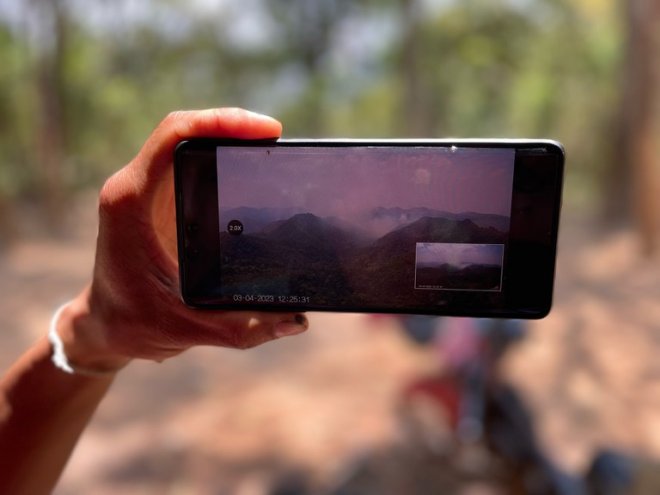 A villager shows the feed from a mountaintop camera that transmits real-time video, such as the smoke from one of the nearby wildfires, on Doi Chang mountain in northern Thailand, on April 4, 2023. Credit: Subel Rai Bhandari for RFA
A villager shows the feed from a mountaintop camera that transmits real-time video, such as the smoke from one of the nearby wildfires, on Doi Chang mountain in northern Thailand, on April 4, 2023. Credit: Subel Rai Bhandari for RFAIn February 2020, Pa Pae village agreed with the local government to be recognized as “a Special Cultural Area” so they could live and farm traditionally.About 21,000 rai, or 3,360 hectares, of land is now protected under the agreement, the first such deal since the new forest law that allows people to reside or utilize certain forest areas, with conditions, for up to 20 years at a time.
“We are responsible for this land … There is trust in the community now,” Deepunu said.
Innovation to tackle village challenges
Deepunu said he is fighting to bring about change to his village “without changing the village in the process” as they battle government regulation, climate change impacts, and the emigration of youth.
He first saw the smoke in mid-March on his smartphone via one of the two cameras he had installed on a mountaintop to monitor the wildfires. The battery-powered equipment can be controlled remotely since they are attached to wireless sim card routers.
 A dozen of 2,000-liter water tanks are kept near an area at risk for fires on Doi Chang mountain, northern Thailand, on April 4, 2023. Credit: Subel Rai Bhandari for RFA
A dozen of 2,000-liter water tanks are kept near an area at risk for fires on Doi Chang mountain, northern Thailand, on April 4, 2023. Credit: Subel Rai Bhandari for RFABefore, a village survey team had to go to the top of the mountain to check for fires. But now the cameras provide an unobstructed, panoramic live view of the area day and night.
The villagers sometimes use drone cameras to monitor smoke and have installed sensors in different places to measure and record temperature and pollution.
These are some of the innovations in the village to prepare for “changes due to global warming and other issues,” said 58-year-old Chanchai.
“We are facing many challenges. The firebreak line is not working as it did traditionally, so we have to think of new ideas,” he added.
Later this year, the village plans to set up “a water spray system” in the forest, which they can remotely turn on when they know a wildfire is on the way.
“If this idea works, it will be great because other ethnic villages could replicate it,” Deepunu said.
Water is available “at just 60% of previous times,” he added. So, the villagers have stored several 2,000-liter water tanks in risk-prone areas. They have also dug a pond in the middle of the village to hold about 400,000 liters of water.
 A Karen villager shows a patch of land in the forest that they farmed in 2022 in Pa Pae, northern Thailand, on April 4, 2023. Credit: Subel Rai Bhandari for RFA
A Karen villager shows a patch of land in the forest that they farmed in 2022 in Pa Pae, northern Thailand, on April 4, 2023. Credit: Subel Rai Bhandari for RFAThe traditional way of farming
Karen communities conduct traditional rotational farming, which requires farmers to burn the area and move their cultivation every year so that the land gets time to regenerate. It has been a sore point with the Thai authorities.
“One family gets a maximum of 5 rai (0.8 hectares) where they grow rice, cassava, and plenty of vegetables. It’s enough,” Jiradet Ngoenkham, a local villager, said.
After cultivation, villagers return to the same area after 7-8 years.
Before and after each harvest, the villagers burn the remains in the farm in a responsible manner, which provides natural nutrients to the soil, said another villager, Kriangkrai Buntha, 37.
“We are cautious. It is never out of control. It has never happened,” he added.
“The rotational cultivation burning is short, fast, and limited, not done all at once. There is not much pollution,” Chi Suwichan Phatthanaphraiwan, a professor of geo-cultural management at Srinakharinwirot University.
However, such slash-and-burn practice has led to public misconceptions about Karen-style farming and air pollution, with the government responding with “zero-burn” policies.
Chatchawan Thongdeelert, a social activist and director of Breath Council, said that approach “blanketly criminalizes the villagers.”
“In the north, we say there are two types of fire: necessary and unnecessary. We will have many unnecessary fires if we do not do necessary ones,” he added.
“We have to be specific about the cause of air pollution. It’s not rotational farming burning, but monoculture agricultural burning, and wildfires.”
Villagers and activists allege things started worsening when industrial-scale farming of maize for animal feed began more than a decade ago, as big companies offered incentives to lure the villagers to switch to the cash crops.
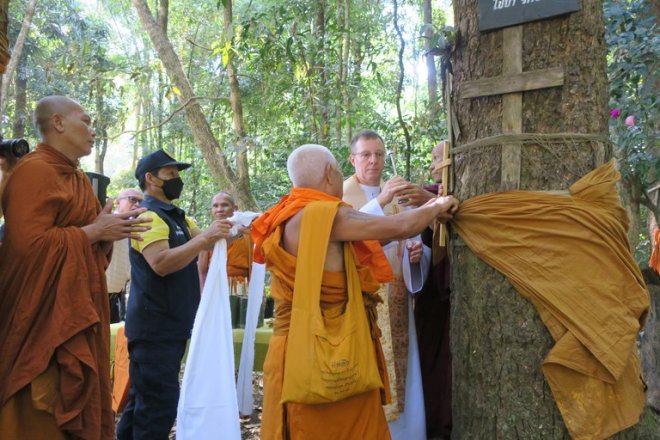 A Catholic priest and Buddhist monks wrap a village tree with an orange robe to protect it from being cut or destroyed in Pa Pae, northern Thailand, on April 4, 2023. Credit: Subel Rai Bhandari for RFA
A Catholic priest and Buddhist monks wrap a village tree with an orange robe to protect it from being cut or destroyed in Pa Pae, northern Thailand, on April 4, 2023. Credit: Subel Rai Bhandari for RFAEnvironmentalists blame maize stubble burning as one of the two reasons for the record-breaking air pollution in northern Thailand.
Pa Pae villagers said they had been approached to do contract maize farming but rejected the offer.
“We rejected because it is not according to traditional living,” Deepunu added. “It affects our culture, belief, and relationship with the forest.”
A Catholic priest and Buddhist monks ordain trees
To keep the local government on their side, Pa Pae villagers prepared a mapping survey system, which informs the geo-locations of where the villagers conduct their shifting cultivation each year, as well as important spots, like spiritual and religious sites and cemeteries.
In early April, Pa Pae villagers organized an event to present the data to government officials and other local communities. District and provincial governors and forest department officials attended it.
A Catholic priest and several Buddhist monks wrapped orange clerical robes around trees to protect forests. It was the first time, the villagers said, for the two religious leaders to come together to show common struggle against environmental degradation.
“Karen are accused of destroying the forest, of burning, but they are not doing that,” Prachoen Samongdee, Ban Hong’s district governor overseeing Pa Pae village, told RFA after the event.
“This community has been in this land for at least 140 years. They have lived together with the forest and used the forest for food,” he said.
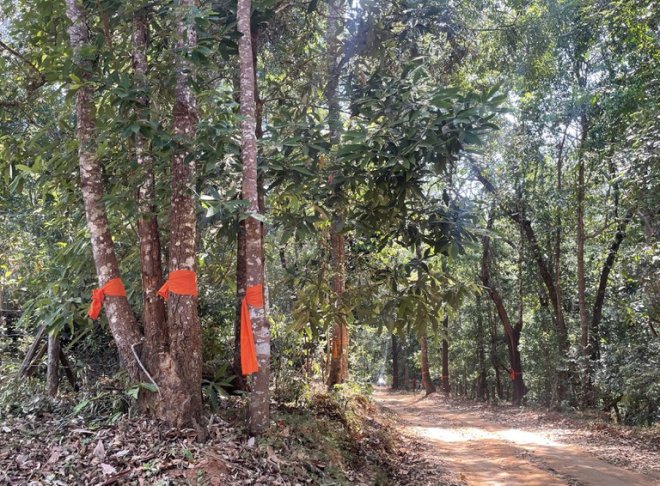 Several village trees are marked as protected from being cut or destroyed in Pa Pae, northern Thailand, on April 4, 2023. Credit: Subel Rai Bhandari for RFA
Several village trees are marked as protected from being cut or destroyed in Pa Pae, northern Thailand, on April 4, 2023. Credit: Subel Rai Bhandari for RFAThe data on land use given by the villagers “is science-based and shows us in detail about the forest and trees,” he said, as authorities can check if there has been any destruction.
Santithorn Yimlamai, the provincial governor of Lamphun, called Pa Pae “an authentic, model village” for cultural protection, saying he will use the data collection as an example for other communities.
“It will also help the government to understand the livelihood of ethnic communities more,” he said. “It shows how ethnic people use land and live together with nature.”
Phrue Odochao, a 52-year-old Karen leader and forest dweller from another community, who came to attend the event said the communities have lived in the forests “for hundreds of years before they became national parks.”
Phrue said climate change is a threat, but the bigger threat is from “the people.”
“For city people, everything is economic. Like they see a green forest, they talk about timber cultivation, carbon credit, and green business,” he said.
“Villagers are the ones who protect nature, but the money goes to the government.”
[圖擷取自網路,如有疑問請私訊]
|
本篇 |
不想錯過? 請追蹤FB專頁! |
| 喜歡這篇嗎?快分享吧! |
相關文章
AsianNewsCast










